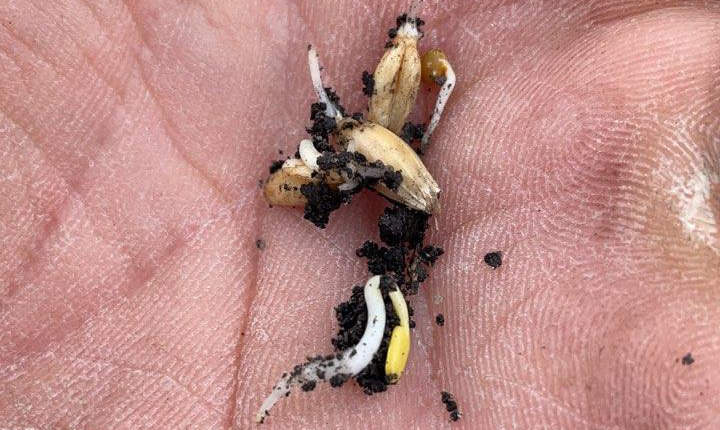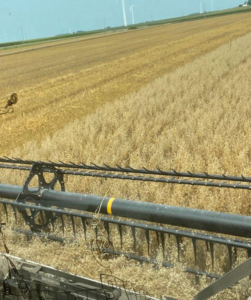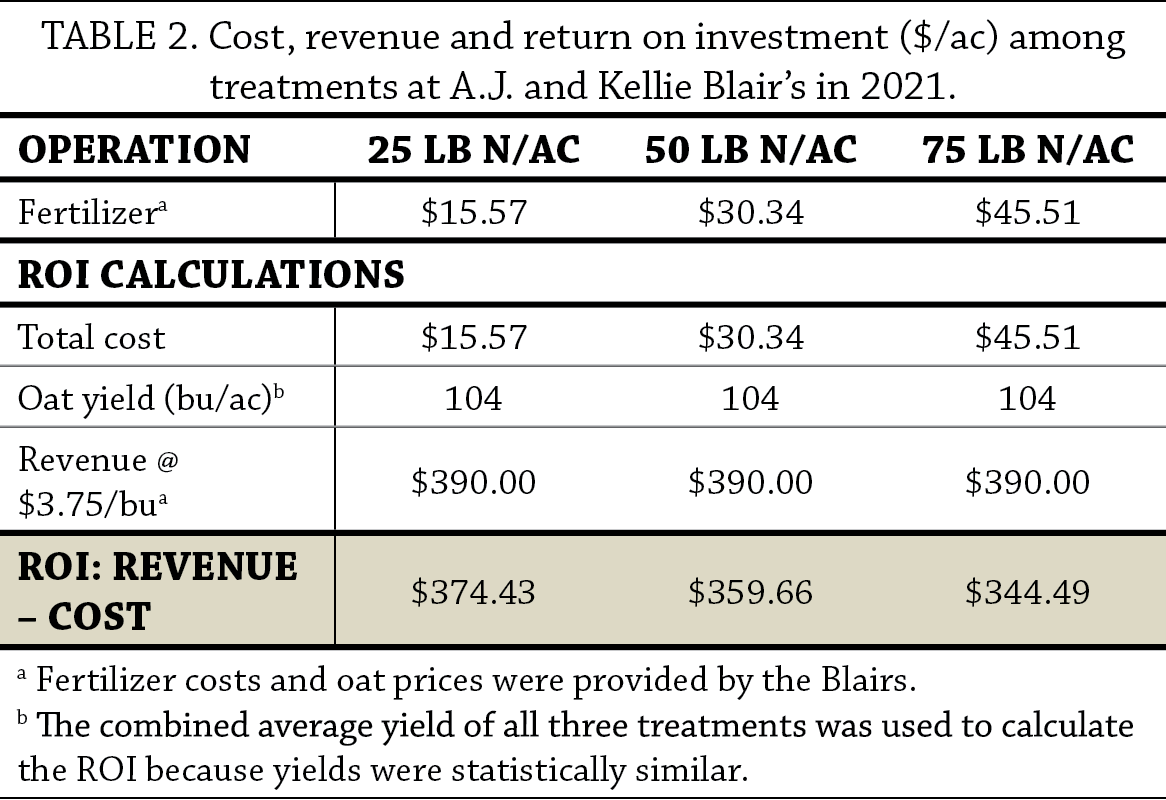This research was funded by the Walton Family Foundation.
In a Nutshell:
- Kellie and A.J. Blair are aiming to fine-tune the nitrogen fertilization regime for their food-grade oat enterprise to maximize yield and profitability.
- The Blairs conducted strip trials to compare oat yield among strips receiving 25 lb N/ac, 50 lb N/ac and 75 lb N/ac.
Key Findings:
- Applying 25 lb N/ac resulted in the same yields as oats to which 50 and 75 lb N/ac was applied while saving the Blairs $15/ac and $30/ac, respectively.
- Results from two years of research conducted by the Blairs show that 25 lb N/ac may be the sweet spot for maximum oat yield and profit on their farm.
Background
For a number of great reasons, A.J. and Kellie Blair diversified their corn-soybean rotation by adding oats and alfalfa in 2018. Diversity spreads risk across multiple enterprises, enhancing the Blair family’s resiliency should they be faced with failure of any single enterprise in a given year. The Blairs also value the benefits of their extended rotation to soil, water and environmental quality. Research has shown that expanding corn-soybean rotations to three or four-year rotations using small grains, green manure cover crops and alfalfa can actually raise corn and soybean yields and maintain weed suppression while reducing synthetic inputs such as nitrogen and herbicides.[1] And because oats are harvested earlier than corn and soybeans, the Blairs are able to plant cover crops earlier in the fall on their oat acreage. This not only extends the cover crop growing period and maximizes its benefits such as holding soil and nutrients in place and managing weeds, but it translates to a less frantic late fall by reducing the number of corn and soybean acres on which to plant cover crops following harvest.

On their diversified family farm, Blair Farm, L.L.C., Kellie (left) and A.J. Blair (right) produce soybeans, corn, oats, rye, alfalfa, cattle and pigs. Photo taken approximately 2019.
The Blairs specifically grow food-grade (i.e. ‘milling’) oats destined for human consumption rather than feed-grade or forage oats for livestock consumption. Milling oats sell for a higher price, but they can be challenging to grow in the Midwest.[2] Warm weather during grain fill and a climate conducive to diseases such as rust and barley yellow dwarf virus make reaching yields and the high test weights required by the milling market difficult.[3,4] Optimum nitrogen fertility –neither too little nor too much – is essential for maximizing yield and test weight, but nitrogen recommendations for milling oats in Iowa are not well understood.[2,4] The Blairs conducted research in 2020 to compare the effects of two nitrogen rates – 0 lb N/ac and 50 lb N/ac – on oat yield and profitability.[5] They found that oats in the treatment that received 50 lb N/ac yielded greater and generated an additional $56.72 in revenue compared to the treatment that did not receive nitrogen. The Blairs repeated the trial in 2021 – this time comparing oat yield and profitability among three different nitrogen rates: 25 lb N/ac, 50 lb N/ac and 75 lb N/ac.
Methods
Kellie and A.J. Blair no-till drilled Rushmore variety oats into soybean stubble on April 1, 2021. Spacing between rows measured 10 in. and the planting population was 1.2 million seeds per acre. Nearly two weeks later (Apr. 14), the Blairs established treatment strips by applying the full amount of nitrogen to each of the three nitrogen-rate treatments. Treatments were replicated 3 times for a total of nine strips, each of which measured 60 ft wide by 1,670 ft long (Figure A1). In each treatment, 50% of the nitrogen was provided from AMS (21-0-0-24S) and the other 50% from urea (46-0-0). Final nutrient totals applied to each treatment are outlined in Table 1.
Measurements
The Blairs harvested oats from the middle 60 ft of each strip and recorded yields from each individual strip on July 24. Yields were adjusted to standard moisture (14%).
Data analysis
To evaluate the effect of N rate on oat 50 lb N/ac 75 yield and profitability, we calculated the 75 lb N/ac 112.5 least significant difference (LSD) at the 90% confidence level using a Tukey’s test. If the difference in average yield between any two of the nitrogen rate treatments was greater than the LSD, we would expect such a difference to occur 90 times out of 100 under the same conditions – we refer to this as a statistically significant effect. On the other hand, if the resulting difference between any two treatments was less than the LSD, we would consider the results to be statistically similar. We could make these statistical calculations because the Blairs’ experimental design involved replication of the treatments (Figure A1).
Results and Discussion
Oat yield
Oat yield in all three treatments was statistically similar (Figure 1). Just as occurred in the previous year of conducting this on-farm research trial, the Blairs experienced low rainfall (Figure A1).[5] Because limited moisture can delay nitrogen mineralization, it is possible the full benefit of additional nitrogen was not realized. Despite low rainfall, the Blairs reported their oats did make test weight at 40 lb/bushel.
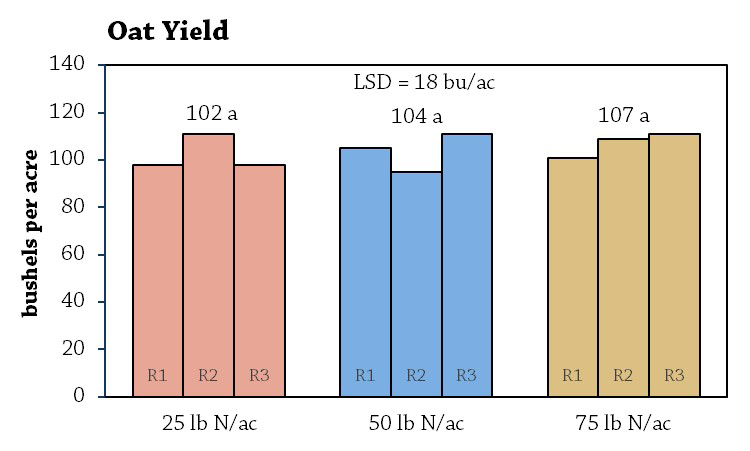
FIGURE 1. Oat yields among treatments at the Blair farm. Columns represent yields for individual strips. The average yield of each treatment is indicated above clusters of columns. Because the difference between any two averages is less than the least significant difference (LSD = 18 bu/ac), the treatment yields are considered statistically similar at the 90% confidence level. Averages followed by the same letter-rankings indicate statistically similar yield. Click to enlarge.
Economic considerations
The return on investment was greatest in the 25 lb N/ac treatment (Table 2). By applying 25 lb N/ac, the Blairs saved nearly $30/ac compared to applying 75 lb N/ac, and nearly $15/ac compared to applying 50 lb N/ac.
Conclusions and Next Steps
The Blairs found that applying nitrogen to oats at a rate of 25 lb N/ac resulted in the same yields as oats to which 50 and 75 lb N/ac was applied while saving them as much as $30/ac. These data add to research the Blairs conducted in 2020, in which they found applying 50 lb N/ac resulted in significantly greater yield and savings of $56/ac compared to applying 0 lb N/ac. Given the relatively recent and growing resurgence of food-grade oat production in Iowa, these two years of research conducted by the Blairs shed some much-needed light on best growing practices for other Iowa farmers interested in adding oats to their rotation. Prior to conducting these trials, the Blairs cited conflicting fertility recommendations – many people said no nitrogen is needed, but the Blairs were impressed with the yield of oats to which 30 lb N/ac was applied at the ISU Northeast Research Farm in Nashua.[3] Their results from two years of research show that 25 lb N/ac may be the ticket to maximum oat yield and profit. Similar research conducted in years with more rainfall would help to further clarify the response of food-grade oats to varying levels of nitrogen fertility.
Appendix – Trial Design and Weather Conditions
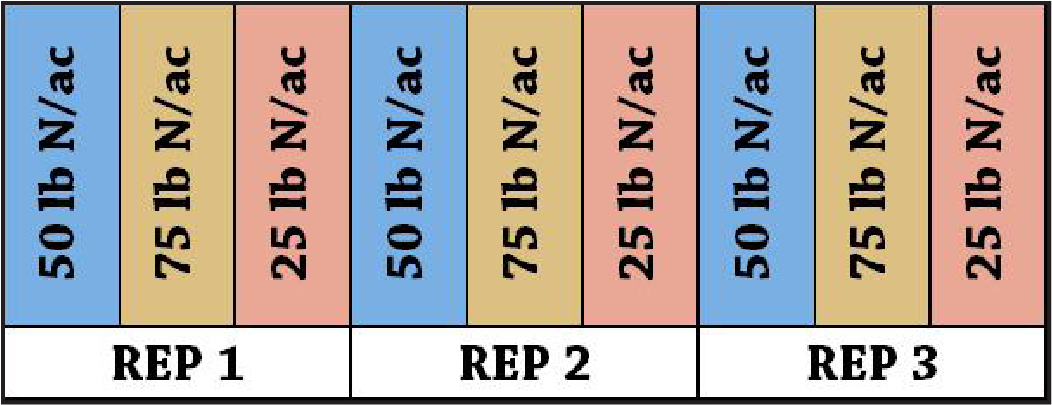
FIGURE A1. Kellie & A.J. Blair’s experimental design consists of three replications of each treatment. This design allows for statistical analysis of the data. Click to enlarge.
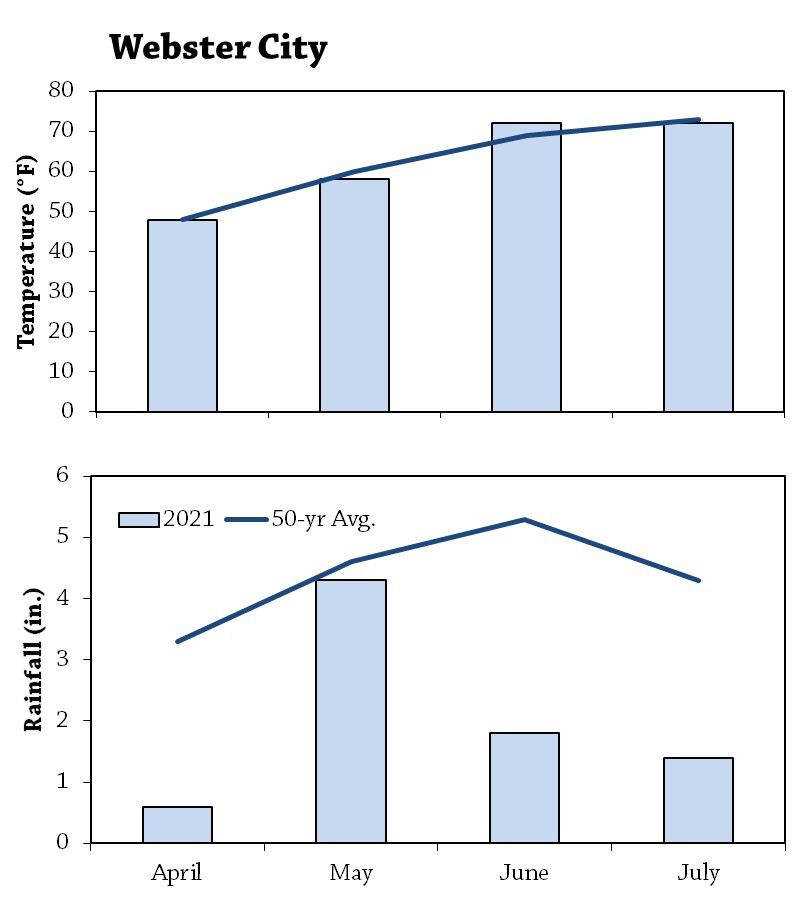
FIGURE A2. Mean monthly temperature and rainfall during the trial period and the long-term averages at Webster City, the nearest weather station to the Blair farm (about 19 miles away).[6] Click to enlarge.
References
- Davis, A.S., J.D. Hill, C.A. Chase, A.M. Johanns and M. Liebman. 2012. Increasing Cropping System Diversity Balances Productivity, Profitability and Environmental Health. PLoS ONE. 7: https://journals.plos.org/plosone/article?id=10.1371/journal.pone.0047149 (accessed June 2021).
- Isleib, J. 2012. Test weight in small grains. Michigan State University Extension. https://www.canr.msu.edu/news/test_weight_in_small_grains (accessed September 2020).
- Gailans, S., L. English, M. Schnabel, K. Pecinovsky, D. Maxwell, R. Rosmann and M. Smith. 2020. Oat Variety Trial 2020. Practical Farmers of Iowa Cooperators’ Program. https://practicalfarmers.org/research/oat-variety-trial-2020/ (accessed August 2021).
- Ransom, J., M.S. McMullen and A. Friskop. 2018. Oat Production in North Dakota. A891. North Dakota State University Extension. https://www.ag.ndsu.edu/publications/crops/oat-production-in-north-dakota (accessed September 2020).
- Nelson, H., K. Blair and A.J. Blair. 2020. Nitrogen Fertilizer for Food-Grade Oats. Practical Farmers of Iowa Cooperators’ Program. https://practicalfarmers.org/research/nitrogen-fertilizer-for-food-grade-oats/ (accessed August 2021).
- Iowa Environmental Mesonet. 2021. IEM “Climodat” Reports. Iowa State University Department of Agronomy. https://mesonet.agron.iastate.edu/climodat/ (accessed August 2021).


